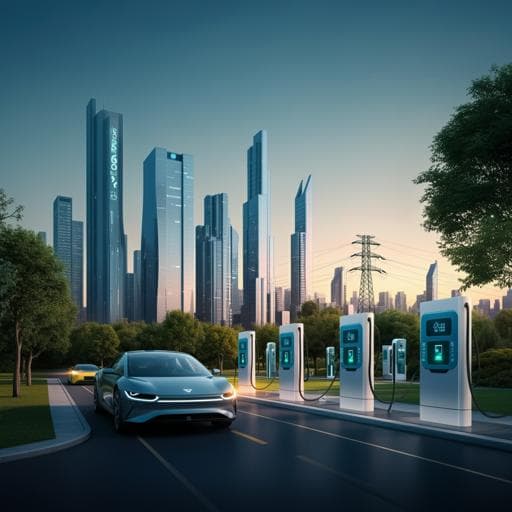
Transportation
Quantifying the impact of vehicle electrification and grid decarbonization on US light-duty vehicle greenhouse gas emissions
M. Woody, G. A. Keoleian, et al.
This groundbreaking study by Maxwell Woody, Gregory A. Keoleian, and Paul D. Viappiani explores how vehicle electrification and grid decarbonization could significantly reduce greenhouse gas emissions from light-duty vehicles in the US by 2035. Discover the potential of reaching a 50% EV sales target by 2030 and its implications for our environment!
~3 min • Beginner • English
Introduction
Literature Review
Methodology
The study builds a state-resolved modeling framework with two main components: (1) a fleet model that projects the number and types of light-duty vehicles (LDVs) by state, powertrain, class, model year, and (2) an emissions model that estimates life-cycle greenhouse gas (GHG) emissions from the fleet. Fleet model: Vehicle stock in each year is computed as prior-year stock plus projected sales minus scrappage based on survival curves. Powertrains are grouped as ICEVs (including ICE gasoline, diesel, CNG, FCV, HEV, PHEV) and EVs (100-, 200-, 300-mile range). Classes are cars and trucks. State fleets are initialized using 2021 EV sales percentages by state and car/truck shares derived from multiple data sources (Alliance for Automotive Innovation, vehicle registrations, and national EV car/truck shares). A logistic adoption curve with carrying capacity K=1 is used to determine a uniform growth rate r across states and classes such that national EV sales reach 50% in 2030. The resulting state-level car and truck EV sales shares in 2030 are constrained to sum to the national target, weighted by each state’s share of national cars/trucks. Emissions model: Use-phase emissions are computed as the product of the number of vehicles, vehicle miles traveled (VMT), and GHG intensity of travel. VMT schedules vary by vehicle class and age and are assumed equal for ICEVs and EVs of the same class (supported by literature showing similar annual VMT for long-range EVs vs ICEVs). For ICEVs, intensity equals life-cycle fuel carbon intensity (kg CO2e/gal) divided by fuel economy (mi/gal). For EVs, intensity equals vehicle electricity consumption (Wh/mi) adjusted for charger efficiency (divide by 0.88) times grid emissions factor (kg CO2e/MWh), with unit conversions. Fuel economy: Annual fuel economies for EVs and ICEVs are based on the DOE VISION Model, using market-share-weighted averages of EV ranges (100/200/300-mile) and ICEV technologies (ICE gasoline/diesel, CNG, FCV, HEV, PHEV). On-road correction factors are applied. Fuel carbon intensities (combustion plus upstream) are taken from GREET and weighted by annual fleet mixes. Grid emissions: State-specific grid emissions factors come from NREL Cambium projections; Alaska and Hawaii use subregional projections averaged by energy output. Two scenarios are modeled: business-as-usual (Cambium midcase) and a 95% decarbonized grid by 2035 (relative to 2005 levels). Emissions include combined combustion and upstream GHG of electricity demand and account for transmission and distribution losses. Vehicle production emissions: Year-specific production emissions (including end-of-life) are interpolated between model year 2020 and 2030 values from literature (Woody et al., 2022). EPA categories are mapped to the study’s car/light truck classes via 2021 sales ratios. Attribution analysis: Emissions changes are decomposed into contributions from fleet turnover, car-to-truck share shifts, vehicle electrification, grid decarbonization, and EV production emissions by calculating emissions under counterfactual static assumptions (e.g., static EV share, static grid intensity) and sequentially adding factors. Early retirement scenarios: Two policies (ER1, ER2) are implemented in 2025–2030 by reducing maximum vehicle age to 20 (ER1) or 15 years (ER2) by 2030 and holding constant thereafter. Vehicle stock size is held equal to the natural-retirement baseline by increasing sales to replace early scrappage. Two pathways are considered for ER1/ER2: (1) base VMT per-vehicle schedule unchanged (fleet VMT rises due to a younger fleet), (2) constant fleetwide VMT achieved by uniformly reducing per-vehicle VMT to keep total VMT unchanged. Base scenario assumptions: EV sales reach 50% by 2030; grid carbon intensity declines from 450 to 340 kg CO2e/MWh (2022–2030) in BAU; ICEV new-vehicle fuel economy improves by ~3 MPG (2022–2030); EV new-vehicle efficiency roughly constant; truck share of sales rises from 67% to 72%; total annual vehicle sales decline by ~1%; age-dependent VMT schedule held constant over time.
Key Findings
- Fleet turnover dominates near-term LDV emissions reductions. In 2030, 80–87% of reductions from 2022 levels are attributable to fleet turnover; in 2035, 50–65% are due to turnover. - Under a baseline where EV sales reach 50% by 2030 and the grid decarbonizes along a business-as-usual trajectory (450→340 kg CO2e/MWh from 2022 to 2030): • By 2030, if EV sales had remained at 4% and the grid at 2022 intensity, LDV emissions would still be 13% (183 Mt) lower than 2022 due to fleet turnover and modest fleet-size changes. • The ongoing shift from cars to trucks causes a small increase in emissions (~10 Mt). • Achieving 50% EV sales in 2030 reduces use-phase emissions by 5% (62 Mt), partially offset by higher EV production emissions (+25 Mt). - Extending to 2035 (BAU grid): • Vehicle electrification contributes an 11% (161 Mt) reduction by 2035 (vs 3% by 2030). • BAU grid decarbonization alone yields only ~5 Mt reduction by 2035. • Achieving 50% EV sales without any grid changes yields a 116 Mt decrease in use-phase emissions by 2035. • Combining electrification and BAU grid decarbonization yields a 193 Mt decrease by 2035, greater than the sum of individual effects, indicating compounding benefits. - With a 95% decarbonized grid by 2035 (vs BAU grid): • The grid-only reduction (no EV sales increases) grows to ~11 Mt by 2035 (vs ~5 Mt under BAU). • Electrification-only reduction remains ~116 Mt by 2035. • Combined grid decarbonization and electrification produce a 317 Mt CO2e reduction by 2035, substantially larger than in BAU (193 Mt). • Under this scenario, with 50% EV sales by 2030, LDV fleet emissions approach a 45% reduction from 2005 levels in 2035. - Relative to 2005 levels, meeting 50% EV sales by 2030 yields a 24% emissions decrease under BAU grid intensity and 26% with a rapidly decarbonizing grid by 2030. About 90% of 2030 LDV emissions would still come from ICEVs. - State vs national modeling: The difference between state-resolved and national-average grid models is <2% per year through 2035 under BAU and <0.5% with faster grid decarbonization. When expressed as a percentage of EV emissions, state-level modeling yields EV emissions up to 7% lower (BAU grid) and up to 4% lower (decarbonized grid) than the national-average model. - Battery materials: Under the base scenario, EV stock reaches 11.5% in 2030 and 30.8% in 2035 (~31 million EV cars and ~47 million EV trucks by 2035), requiring ~7.5 TWh of batteries (current sizes). This is roughly equal to manufacturing capacity using U.S. lithium reserves but well below capacity using global lithium reserves (~209 TWh). U.S. reserves for cobalt and nickel imply more limited capacities (~0.7 TWh and ~0.2 TWh), compared to global reserves (~94 TWh cobalt, ~157 TWh nickel). These estimates assume NMC-811 chemistry; constraints could be alleviated by higher energy density, improved vehicle efficiency, recycling, and alternative chemistries (e.g., LFP, Na-ion). - Additional policy stringency (CAA Section 177 states meeting 67% EV sales by 2030): Raises national EV sales from 50% to 52% in 2030 (7.6→8.0 million) and 89% to 90% in 2035 (13.4→13.5 million). Impacts on EV stock are <1% annually; GHG impacts are <1% in 2030 and ~1% in 2035 across grid scenarios. - Additional strategies (beyond electrification and grid decarbonization): Halting or reversing the trend toward trucks could offset the associated emissions increase. Early retirement policies and reducing vehicle miles traveled (VMT) can yield larger reductions, especially when combined with rapid electrification and grid decarbonization.
Discussion
The analysis shows that near-term LDV GHG reductions in the United States are largely constrained by the pace of fleet turnover, with ICEVs continuing to dominate emissions through 2030 even under aggressive EV sales targets. Electrification and grid decarbonization have compounding effects: while each alone provides limited reductions by 2030, their combined impact grows substantially by 2035 and beyond as EV stock shares rise and grid carbon intensity falls. The study addresses the question of how much emissions reduction can be achieved by 2030 and 2035 by quantifying contributions from fleet turnover, electrification, grid decarbonization, and market shifts between cars and trucks, and by evaluating sensitivity to state-level policy variation and additional strategies such as early retirement and VMT reduction. Results indicate that federal goals for EV sales implicitly depend on some states adopting more stringent policies; however, the benefit of targeting EV deployment to low-carbon grids is modest and diminishes with further grid decarbonization. The findings underscore the importance of integrating policies: strengthening ICEV fuel economy during the transition, accelerating EV adoption, aggressively decarbonizing the grid, managing vehicle size mix (cars vs trucks), and implementing demand-side measures to reduce VMT. Coordinated strategies can achieve emissions reductions approaching 45–50% by 2035 relative to 2005 levels, positioning the sector on a trajectory toward longer-term carbon neutrality.
Conclusion
- Most of the LDV emissions reduction through 2030 derives from natural fleet turnover; electrification and grid decarbonization benefits scale over time as EVs diffuse. - Achieving 50% EV sales by 2030, alongside grid decarbonization, yields compounding reductions and makes a 50% LDV emissions cut by 2035 plausible, particularly when combined with policies to reduce VMT, accelerate retirement of older ICEVs, and curb the shift toward larger trucks. - Despite substantial progress by 2030 (24–26% reduction vs 2005), LDV emissions alone will likely fall short of contributing proportionately to an economy-wide 50–52% reduction target by 2030, implying broader transportation sector shortfalls without additional measures. - Future work should refine uncertainties in battery production emissions, fuel economies, and grid pathways; expand modeling of behavioral and technological trends (e.g., shared mobility, automation, charging behavior); and assess targeted policies that prioritize replacing high-emitting ICEV miles with EV miles.
Limitations
- Modeling uncertainties include future ICEV and EV fuel economies, EV battery production emissions, and grid decarbonization trajectories. - Behavioral and systemic factors not explicitly modeled could materially impact results: rebound effects, changes in vehicle lifetimes, shared mobility and ride-hailing, connected/automated vehicles, micro-mobility, vehicle-to-grid, charging behavior, and heterogeneous consumer preferences. - The car-to-truck trend is incorporated, but broader shifts in vehicle size and power and socio-cultural expectations may alter outcomes. - Materials availability constraints are summarized at a high level; real-world supply chains, recycling rates, technology shifts (e.g., adoption of LFP/Na-ion), and policy interventions could change feasibility timelines. - State vs national grid differences yield relatively small short-term discrepancies, which diminish as the grid decarbonizes; localized strategies may have limited temporal windows for added benefits.
Related Publications
Explore these studies to deepen your understanding of the subject.







